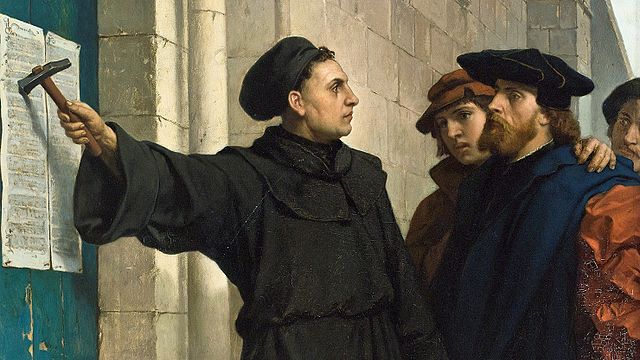The Protestant Reformation, a religious movement that began in the sixteenth century, brought an end to the ecclesiastical unity of medieval Christianity in western Europe and profoundly reshaped the course of modern history. Sometimes called the Protestant revolution, the Reformation appealed to the founders of the United States, and some of its concepts of individualism and free expression of religion are incorporated into the First Amendment.
Protestant Reformation began in 1517 with Martin Luther
Originally, the word reformation (from the Latin reformare, “to renew”) suggested the removal of impurities and corruption from church institutions and people, rather than separation from the unified Roman Catholic Church (the word catholic meaning “universal”). The reformers were not initially called Protestants, but the term later was applied to all groups opposed to the orthodoxy of the Catholic Church.
The Reformation generally is recognized to have begun in 1517, when Martin Luther (1483–1546), a German monk and university professor, posted his ninety-five theses on the door of the castle church in Wittenberg. Luther argued that the church had to be reformed. He believed that individuals could be saved only by personal faith in Jesus Christ and the grace of God. He thought the Catholic Church’s practices focusing on works (such as pilgrimages, the sale of indulgences to obtain forgiveness, and prayers addressed to saints) were immoral. He also advocated the printing of the Bible in the language of the reader, rather than in Latin. (Printing on a large scale had become possible through the introduction of movable type in Europe in 1447 by a German goldsmith, Johannes Gutenberg; it allowed rapid dissemination of ideas, including Luther’s.) The pope condemned the Reformation movement, and Luther was excommunicated from the church in 1521.
The Reformation did not arise in a vacuum. Its rise was influenced by currents of nationalism, mercantilism, anticlericalism, and opposition to vested property interests in the hands of the church that had begun in the late fourteenth century. Among the earliest of those calling for a return to biblical teachings were John Wycliffe, at Oxford University, and Jan Hus, at Charles University, Prague. The church burned Wycliffe posthumously as a heretic in 1384 and condemned and executed Hus in 1415.

Most settlers in the thirteen colonies that eventually formed the United States were Protestants; indeed, several had established Protestant churches. Roger Williams (1603–1683, pictured here) was an early proponent of disestablishment, a movement later led by more secular leaders such as Thomas Jefferson and James Madison. (Image via New York Public Library, by James Charles Armytage, public domain)
Reformation movement spread throughout western Europe
After Luther’s protest a century later, the reform movement erupted in several places, especially in Germany, and spread throughout western Europe. It was led by famous reformers such as John Calvin (1509–1564) and Huldrych Zwingli (1484–1531) in Switzerland and John Knox (1513–1572) in Scotland. Other important leaders were Philipp Melanchthon (1497–1560), Martin Bucer (1491–1551), and Heinrich Bullinger (1504–1574).
The reformers rejected the authority of the pope as well as many of the principles and practices of Catholicism of that time. The essential tenets of the Reformation are that the Bible is the sole authority for all matters of faith and conduct and that salvation is by God’s grace and by faith in Jesus Christ. Although King Henry VIII of England at first opposed the ideas of Luther, calling himself the “defender of the faith,” he broke with the Catholic Church in the 1530s and brought England under the broad reform movement.
Traces of Protestant and Catholic conflicts are still visible in the United States today
Most settlers in the thirteen colonies that eventually formed the United States were Protestants; indeed, several had established Protestant churches. Roger Williams (1603–1683) was an early proponent of disestablishment, a movement later led by more secular leaders such as Thomas Jefferson and James Madison.
Thomas Curry, a contemporary Catholic bishop and historian, argues that the influx of Roman Catholic immigrants to the United States in the nineteenth century later challenged an unofficial Protestant establishment that was especially prominent in public schools and institutions. Nineteenth-century legal conflicts between Protestants and Catholics have sometimes been replaced by twentieth-century conflicts between those who oppose any government aid to religious institutions and those who think that such aid is appropriate if it extends to religious institutions in general and if it is designed primarily to further secular purposes.
This article was published in 2009. Robb Harvey is a partner at Waller and head of the intellectual property litigation group. His practice includes media, intellectual property, franchise and complex commercial litigation. Robb was one of the founders of the Tennessee Coalition for Open Government and is a leader in national and state media organizations, including the Media Law Resource Center and the ABA Forum on Communications Law.

